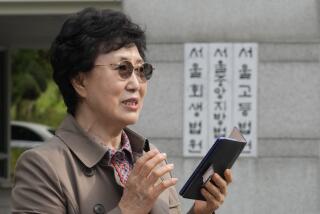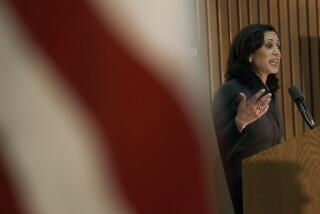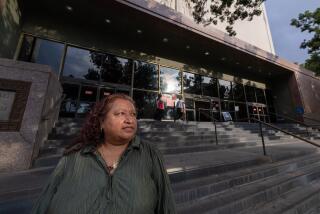Standing Up for Children : Volunteers: More than 100 lawyers with the Children’s Rights Project of Los Angeles donate their services to help protect youths’ legal rights.
Pamela Mohr may have the only law office in Los Angeles with a toy steam engine on the desk and teddy bears beside the law books.
“I wish I could say the toys are just for the kids,” says Mohr, “but I can’t claim that. A lot of times when I’m going absolutely berserk, I’ll take the toys and play with them. It helps keep me sane.”
For the record:
12:00 a.m. June 14, 1991 For the Record
Los Angeles Times Friday June 14, 1991 Home Edition View Part E Page 4 Column 3 View Desk 1 inches; 31 words Type of Material: Correction
Legal rights--The Children’s Rights Project of Los Angeles, featured in a June 4 View story, is operated and funded by Public Counsel, the public-interest law office of the Los Angeles County and Beverly Hills Bar assns.
Mohr is founder of the Children’s Rights Project of Los Angeles, a group of 150 lawyers who volunteer their services to children in non-criminal cases, including custody. Since 1986, when the project began, lawyers have:
* Reunited five siblings who had been placed in separate foster homes.
* Recovered life insurance benefits that had been stolen by a grandfather.
* Won a court order allowing a girl with a violent, mentally unstable mother to live with relatives out of state.
* Helped a developmentally disabled teen-ager by providing legal assistance to a man seeking to adopt him.
“Kids do have rights, but they aren’t self-enforcing,” says Mohr, a UCLA School of Law graduate whose parents and grandmother were also attorneys. “You need somebody out there to first of all inform them and second of all to speak up on their behalf.”
Mohr’s group does just that, and has won praise from the legal and child-care communities.
“Pamela Mohr and the Children’s Rights Project have truly been in the forefront of local efforts to focus attention on the legal rights children have or should have throughout the juvenile justice system,” says Paul Boland, former presiding judge of the Los Angeles County Juvenile Court and now a Superior Court judge in Pasadena.
“I have absolute respect for Pam Mohr and the work she and the Children’s Rights Project do,” adds Nina Jaffe, executive director of the Westside Children’s Center in Santa Monica. “She has been an invaluable resource in terms of helping us understand the juvenile court process.”
The project, says Mohr, covers children in Los Angeles County, where 50,000 children are under court jurisdiction and another 10,000 to 30,000 are homeless or runaways.
Carol Mink received help two years ago when she arrived in Los Angeles at age 17, seeking legal emancipation from her alcoholic, possessive mother who lived in Maryland.
“I’m the type of person who has to be able to make my own mistakes and lead my own life, and she would not let me do that,” says Mink, who now lives in Reseda.
“Mother has been an alcoholic. She has been ever since I can remember. She doesn’t listen to me. I found it very difficult. I was not allowed to go anywhere. I was not allowed to do anything.”
Mink sought advice from a friend who recommended the Children’s Rights Project, which accepts about 275 cases a year referred by teachers, social workers and other attorneys. Social workers screen applicants for eligibility into the program, which is open to “any child who has a specific need and requires legal assistance,” says social worker Michele Sartell.
Through the project, Mink was put in touch with Universal City attorney Gregory Patterson. She finished high school while working nights in a Sherman Oaks clothing store, where she is now assistant manager.
“Without talking to the Children’s Rights Project, I would have never known I could do it,” Mink says.
And without the project, she couldn’t have afforded to go ahead with the case.
“Financially, she would not have been able to hire an attorney . . .,” says Patterson, who normally would have charged $900 to $1,500. “I think she could have appeared on her own behalf, but it’s difficult getting through the documents and the maze you have to go through.”
Often the children represented are much younger than Mink. Patricia Phillips’ client was an 8-year-old girl whose father sought to re-establish contact after serving a prison term for shooting the girl’s mother.
Phillips, former president of the Los Angeles County Bar Assn., persuaded the court to allow the father visitation only in the presence of a monitor. It took four associates in Phillips’ downtown firm to rebuff the father’s repeated appeals. They worked up what would have been a $300,000 bill, Phillips said.
“I don’t think any of us anticipated we would be taking as much time as we did,” she says, “but you don’t back off once you start.”
Phillips and other attorneys in the project often take cases far afield from their specialties. Los Angeles lawyer David Grunwald, who handles business and product liability cases, stopped distribution of posters and films using developmentally disabled children as unauthorized models.
“It was the highlight of my legal career,” says Grunwald. “The day the defendant’s counsel called and said they were willing to settle, I had a buzz unparalleled.”
Says Steve Nissen, executive director of Public Counsel: “These cases require not only intellectual acumen . . . but a kind of passion that a lot of lawyers lack.
“Coming out of that passion there are going to be some high days when you accomplish a lot and some terribly depressing days. This isn’t like losing a big commercial case where one party gets the money and another doesn’t. You lose a case here and you’ve really lost a life, or the quality of life, for someone.”
Volunteers also like being on the cutting edge of the law. “One reason attorneys get very scared and very excited by this area is that . . . often you do ground-breaking work,” says Mohr.
Adds Boland: “It’s only been in the last decade that the rights of children to access to the court system and to services has been acknowledged and respected. . . . I’d say we’re no more than 10% to 20% of the way there.”
Mohr’s early interest in the law developed in Chicago, where she grew up in a quiet middle-class neighborhood. Her grandmother, Esther Mohr, graduated from law school and helped found the local chapter of the American Civil Liberties Union. Her mother, Elaine, practiced law for one year before raising a family. Her father, David, also was an attorney.
“I think part of that rubbed off,” says Mohr, 34. “I did see this as something a girl or woman could do. It never occurred to me there would be stumbling blocks and problems or any kind of prejudice toward women.”
At Carleton College in Northfield, Minn., she considered working with children either as a teacher or social worker before choosing law.
“I’ve just always adored kids,” says Mohr who is unmarried and has no children, but plans to take in foster children at her home in the San Fernando Valley.
After graduating from UCLA in 1984, she worked at a downtown law firm for two years before moving to Public Counsel, a public-interest law office of the Beverly Hills and Los Angeles County Bar associations.
“There are all kinds of different legal service organizations throughout Los Angeles that do important things,” she says. “But nobody focused on the kids . . . so I started pushing for a program that would.”
She started the Children’s Rights Project with about 10 lawyers; today, there are 150 who take up to three cases a year. Mohr says if she could afford two more staff lawyers to provide support, she could attract another 500 volunteers.
The attorneys rely on a full-time and a part-time social worker who constitute the project’s staff. The program is funded by individuals, corporations, foundations and law firms, but accepts no government aid.
“That’s by choice. A lot of times the government is involved in the problems. And there are a lot of limitations when you take government funding in terms of types of clients you can serve and types of issues you can raise,” says Mohr during an interview in her Mid-Wilshire office. She is wearing a brown suit and a cream-colored blouse, but only because she is about to have lunch with a judge. Her preference at work is jeans and sweat suits.
Of all the cases to come to the Project, Mohr remembers one in particular where a court had placed five children--ages 1 to 10--in four separate foster homes throughout the county because of problems at home. A lawyer for the project was able to reunite the children with their parents.
“When you see not only the difference you can make in terms of keeping a family together, but that you can really get some services for the family,” says Mohr, “that’s when you really feel like you make a difference.”
More to Read
Sign up for Essential California
The most important California stories and recommendations in your inbox every morning.
You may occasionally receive promotional content from the Los Angeles Times.










